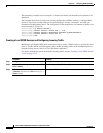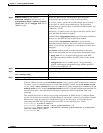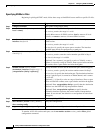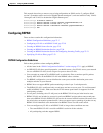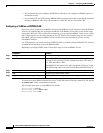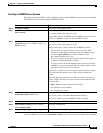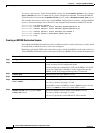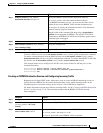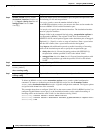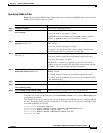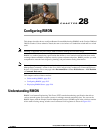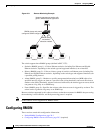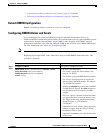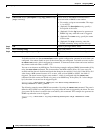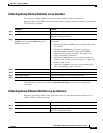
27-22
Catalyst 2960 and 2960-S Switch Software Configuration Guide
OL-8603-09
Chapter 27 Configuring SPAN and RSPAN
Configuring SPAN and RSPAN
To delete an RSPAN session, use the no monitor session session_number global configuration
command. To remove a destination port from the RSPAN session, use the no monitor session
session_number destination interface interface-id global configuration command. The ingress options
are ignored with the no form of the command.
This example shows how to configure VLAN 901 as the source remote VLAN in RSPAN session 2, to
configure Gigabit Ethernet source port 2 as the destination interface, and to enable forwarding of
incoming traffic on the interface with VLAN 6 as the default receiving VLAN.
Switch(config)# monitor session 2 source remote vlan 901
Switch(config)# monitor session 2 destination interface gigabitethernet0/2 ingress vlan 6
Switch(config)# end
Step 4
monitor session session_number
destination {interface interface-id
[, | -] [ingress {dot1q vlan vlan-id |
untagged vlan vlan-id | vlan
vlan-id}]}
Specify the SPAN session, the destination port, the packet encapsulation, and
the incoming VLAN and encapsulation.
For session_number, enter the number defined in Step 4.
In an RSPAN destination session, you must use the same session number for
the source RSPAN VLAN and the destination port.
For interface-id, specify the destination interface. The destination interface
must be a physical interface.
Though visible in the command-line help string, encapsulation replicate is
not supported for RSPAN. The original VLAN ID is overwritten by the
RSPAN VLAN ID, and all packets appear on the destination port as untagged.
(Optional) [, | -] Specify a series or range of interfaces. Enter a space before
and after the comma; enter a space before and after the hyphen.
Enter ingress with additional keywords to enable forwarding of incoming
traffic on the destination port and to specify the encapsulation type:
• dot1q vlan vlan-id—Forward incoming packets with IEEE 802.1Q
encapsulation with the specified VLAN as the default VLAN.
• untagged vlan vlan-id or vlan vlan-id—Forward incoming packets with
untagged encapsulation type with the specified VLAN as the default
VLAN.
Step 5
end Return to privileged EXEC mode.
Step 6
show monitor [session
session_number]
show running-config
Verify the configuration.
Step 7
copy running-config
startup-config
(Optional) Save the configuration in the configuration file.
Command Purpose



